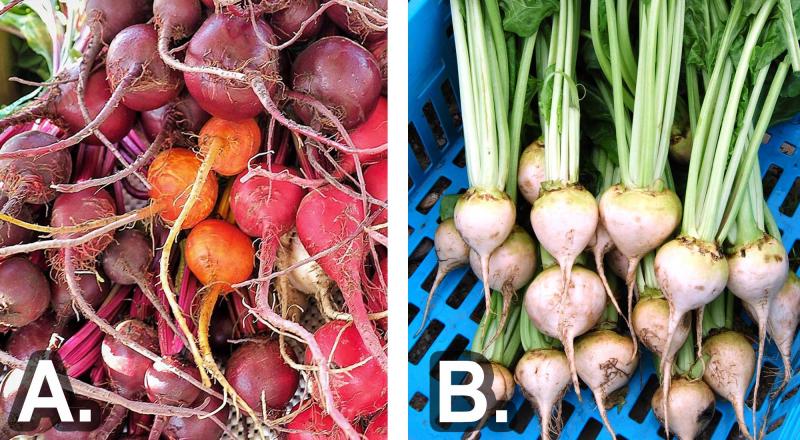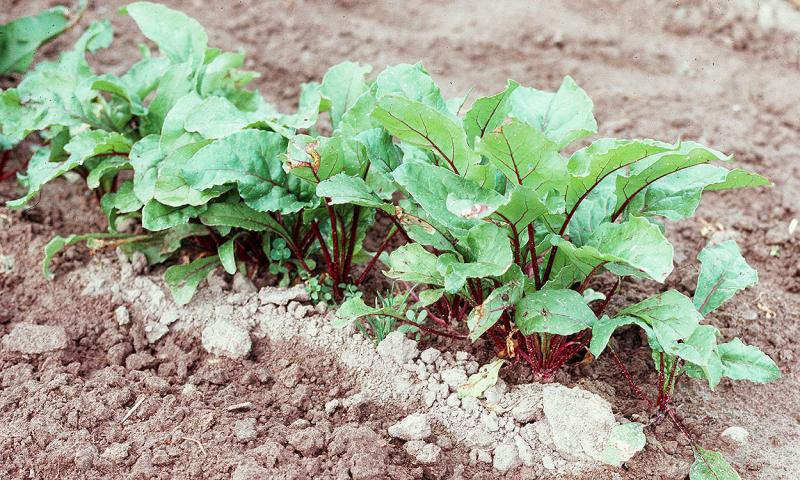Written by Rhoda Burrows, former Professor & SDSU Extension Horticulture Specialist.
Description

General Description: Beets are commonly grown for their bulbous roots, but their tops can also be harvested for greens, and they are an excellent source of Vitamin A as well as calcium. Beet juice is sometimes used in flavoring and for coloring ketchup and tomato juice. Swiss chard is a very close relative. Both are the species Beta vulgaris.
Types: Red beets are the common garden type (Figure 1-A), also known as table beet. Edible beets can also be golden, white (Figure 1-B) or internally striped (as in the Chiogga beet). There are other types of beets, such as sugar beets or forage beets, but these are not consumed by humans.
Planting

Timeline: Beets grow best in the cooler temperatures of spring or fall (Figure 2). The plants can tolerate light frosts. For a continuous supply of tender beet greens and roots, sow every two weeks until late May. Plant again in mid- to late-August for a fall harvest. In gardens, beet roots can grow 3-to-4 feet deep in good soil. However, because of their small size, beets can easily be grown in containers or raised beds.

Sowing and Transplants: Plant beet seed directly into the soil once soil temperatures have reached 45° Fahrenheit. Light or loamy soil is preferred. Heavy clay soil should be amended with compost or other organic matter. Plant seeds ½ inch deep and one inch apart. Each beet seed will produce 2-to-6 plants, which will need to be thinned.
Alternatively, beets can be sown indoors about 5- to-6 weeks before transplanting. Transplants should be set 3 inches apart. Transplanting reduces the time to harvest by 2-to-3-weeks. If grown in a container, or in wide rows, there should be between 5 and 9 beet plants per square feet.
Thinning: Thin beets once their tops reach a usable size, about 3-to-4 inches tall (Figure 3). The plants should be thinned to 2-to-3 inches apart.
Plant Care
Watering:
- Beets need to be well-irrigated for best quality, but they should also have good drainage.
- Make sure the soil is thoroughly wetted after each watering.
- Once plants are several inches high, let the top half-inch or so dry before watering again.
Fertilizing:
- Nitrogen: Apply ¾ to 1 cup of urea per 100 square-feet.
- Phosphorus and Potassium: Apply according to soil test recommendations.
Weeding:
- Frequent shallow cultivation is recommended to keep weeds under control.
Pests and Diseases

Major Pests
- Flea Beetles: Flea beetles chew small, round holes in leaves (Figure 4-A). They can heavily damage the crop, especially when the plants are very young. Planting mustard greens, such as arugula or radishes near the beets can sometimes act as a trap crop.
Major Diseases
- Cercospora Leaf Spot: Avoid this disease by not planting beets in the same spot two years in a row and by removing any remaining plant debris after harvest.
Minor Problems
- All Tops: All tops with no roots or small roots is a condition usually caused by planting too close or by not thinning plants (Figure 4-B). Excessive nitrogen fertilization can also contribute to extensive top growth at the expense of root growth.
- Tough Roots: Tough roots can be caused by drought or too high soil temperature, along with white interior rings.
Harvest
Harvest: Thinned plants can be cooked with the root and top together. Beet greens can be harvested as soon as they are large enough, but if the gardener wants to harvest roots also, only one or two leaves should be taken from each plant.
Mature roots are generally ready to harvest 6-to-8 weeks after planting, when they have reached the size of a golf ball. They can be dug with a potato fork or similar tool.
Average Yield: 10 pounds per a 10-foot row.
Storage and Preparation
Storage: Roots will keep 2 weeks or more under refrigeration; beet greens 1-to-2 days. Cut off tops and store beets in a cool, humid place with temperatures ranging from 32°to 40° Farenheit. Do not allow them to freeze.
Cooking Tips: For information on preparing beets, see our Pick it! Try it! Like it! resource for beets.
Nutrition Facts: Beets are a low-calorie food. One cup of cooked beets contains about 75 calories. Beets are an excellent source of folate (this can vary by variety) along with vitamins A and K and dietary fiber. Some studies suggest that red beets may also have considerable cancer-fighting properties.


